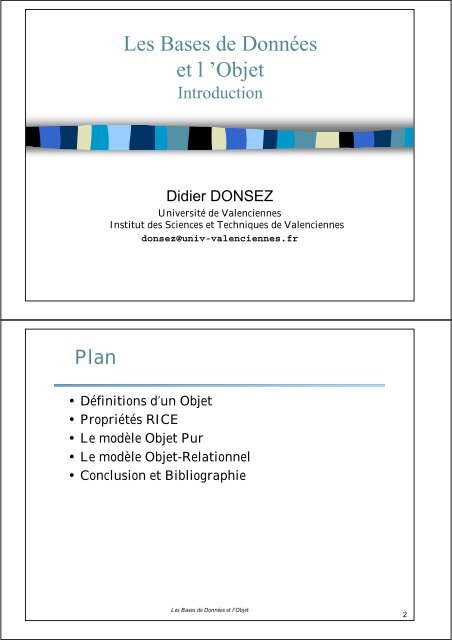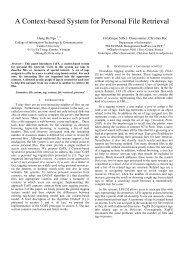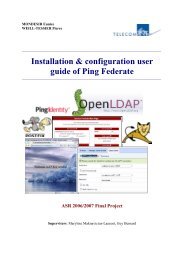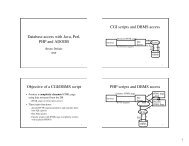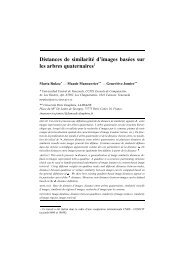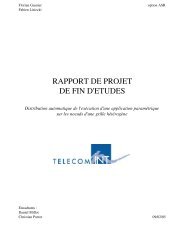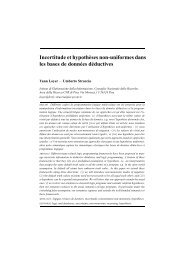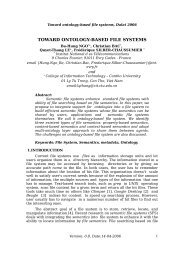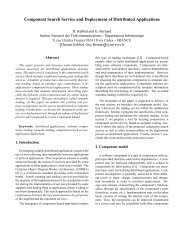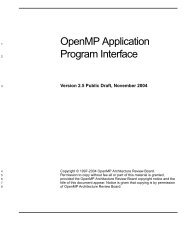Les Bases de Données et l 'Objet
Les Bases de Données et l 'Objet
Les Bases de Données et l 'Objet
- No tags were found...
You also want an ePaper? Increase the reach of your titles
YUMPU automatically turns print PDFs into web optimized ePapers that Google loves.
<strong>Les</strong> <strong>Bases</strong> <strong>de</strong> Données<strong>et</strong> l ’Obj<strong>et</strong>IntroductionDidier DONSEZUniversité <strong>de</strong> ValenciennesInstitut <strong>de</strong>s Sciences <strong>et</strong> Techniques <strong>de</strong> Valenciennesdonsez@univ-valenciennes.frPlan• Définitions d’un Obj<strong>et</strong>• Propriétés RICE• Le modèle Obj<strong>et</strong> Pur• Le modèle Obj<strong>et</strong>-Relationnel• Conclusion <strong>et</strong> Bibliographie<strong>Les</strong> <strong>Bases</strong> <strong>de</strong> Données <strong>et</strong> l'Obj<strong>et</strong>2
Limite du Relationnel■ Très bon support théorique■ mais Modèle « plat »• Difficile d ’exprimer <strong>de</strong>s choses structurées• Première forme normale• Difficile <strong>de</strong> naviguer dans la structure• Jointure<strong>Les</strong> <strong>Bases</strong> <strong>de</strong> Données <strong>et</strong> l'Obj<strong>et</strong>3Définitions d’un Obj<strong>et</strong>■ Pas <strong>de</strong> définition universelle <strong>de</strong> l’Obj<strong>et</strong>• OMG• chose i<strong>de</strong>ntifiable ...• Ferber• entité informatique complète i<strong>de</strong>ntifiable caractèrisée parson état <strong>et</strong> un ensemble <strong>de</strong> métho<strong>de</strong>s• ANSI X3H7• http://www.objs.com/x3h7<strong>Les</strong> <strong>Bases</strong> <strong>de</strong> Données <strong>et</strong> l'Obj<strong>et</strong>5
<strong>Les</strong> « Manisfesto »■ Codd, 1969• Modèle relationnel■ Cood, 1990• Modèle relationnel V2■ Atkinson <strong>et</strong> al, 1989• The Object-Oriented Database System Manifesto■ Stonebraker <strong>et</strong> al, 1990• Third Generation DataBase System Manifesto■ Darwen <strong>et</strong> Date, 1995• The Third Manifesto<strong>Les</strong> <strong>Bases</strong> <strong>de</strong> Données <strong>et</strong> l'Obj<strong>et</strong>6Deux Approchesen <strong>Bases</strong> <strong>de</strong> DonnéesLe modèle Orienté Obj<strong>et</strong> (OO)Le modèle Obj<strong>et</strong>-Relationnel (OR)Smalltalk, C++, ...OODBMSManisfesto (90)ODMG-93(91-93)ODMG-II(97)ODMGCA-Jasmine,ObjectStore, O2,Versant, POET, ...Codd (69)le modèleSQL relationnel(85)SQL2(92)SQL3(96,97,98,99)SQL4ANSI X3H2Convergence (??) ISO/IEC JTC1/SC21/WG3? Oracle, Informix,Sybase, IBM DB2,<strong>Les</strong> <strong>Bases</strong> <strong>de</strong> Données <strong>et</strong> l'Obj<strong>et</strong>CA-OpenIngres, ...7
les SGBD Orientés Obj<strong>et</strong>■ Modèle obj<strong>et</strong> «pur»• Persistance• orthogonal au type• langages : C++, Smalltalk, Java / OQL• Produits• O2, ObjectStore, Ontos, Objectivity, Jasmine• Niches technologiques• réseau, CAO, SIG, Gestion <strong>de</strong> Données Techniques, ...• pas <strong>de</strong> transactionnel lourd<strong>Les</strong> <strong>Bases</strong> <strong>de</strong> Données <strong>et</strong> l'Obj<strong>et</strong>8Problématiquedu modèle Obj<strong>et</strong> Relationnel■■■Modèle relationnel• Codd, IBM San José, 1969Avantages• Simplicité <strong>de</strong>s concepts basé sur les ensemblesLimites• pas <strong>de</strong> données complexes ou fortement structurées• inadapté aux applications navigationnelles• réseaux, CAO/CFAO BTP-Méca, AGL, SIG, Web• pas <strong>de</strong> types nouveaux• volumineux ou/<strong>et</strong> multimédia (BLOB)<strong>Les</strong> <strong>Bases</strong> <strong>de</strong> Données <strong>et</strong> l'Obj<strong>et</strong>9
Approches d'extensiondu modèle relationnel■ 2 principales approches• au niveau <strong>de</strong> la relation• imbrication <strong>de</strong> relations• UNISQL, Illustra-Informix• au niveau du domaine• Oracle 8, SQL 3, MicroSoft<strong>Les</strong> <strong>Bases</strong> <strong>de</strong> Données <strong>et</strong> l'Obj<strong>et</strong>10La normalisation SQL-3■ 2 comités• ANSI X3H2• ISO/IEC JTC1/SC21/WG3■ Partie <strong>de</strong> la norme ISO/IEC 9075 (SQL3)• Part 1: SQL/Framework Framework• Part 2: SQL/Foundation UDT, Héritage• Part 3: SQL/Call-Level Interface ODBC,JDBC,OLE DB• Part 4: SQL/Persistent Stored Modules Stored Procedures• Part 5: SQL/Bindings Embed<strong>de</strong>d and Dynamic SQL• Part 6: SQL/Transations XA Specialization• Part 7: SQL/Temporal Time Series data• Part 8: Exten<strong>de</strong>d Objects supprimé <strong>et</strong> intégré dans 2• Part 9: SQL/Med Management of external data(BLOB, datalink types, abstract tables)<strong>Les</strong> <strong>Bases</strong> <strong>de</strong> Données <strong>et</strong> l'Obj<strong>et</strong>• Part 10: SQL/OLB SQLJ (embed<strong>de</strong>d SQL for Java)11
La normalisation SQL-3La suite• curseur restant ouvert après le commit• nouveaux types <strong>de</strong> jointure• vues temporaires• privilèges spécifiques par colonne• modification <strong>de</strong> vues•syncpoints sur plusieurs sessions• héritage <strong>de</strong> table : sous tables <strong>et</strong> super tables• textes longs <strong>et</strong> types multimédia (SQL/MM)• données spatiales <strong>et</strong> seismiques, ...<strong>Les</strong> <strong>Bases</strong> <strong>de</strong> Données <strong>et</strong> l'Obj<strong>et</strong>12<strong>Les</strong> Propriétés RICE (Miranda)Réutilisation• finalité du paradigme obj<strong>et</strong>héritage, généralité, composition, polymorphismeI<strong>de</strong>ntité• i<strong>de</strong>ntifier un obj<strong>et</strong> <strong>de</strong> manière uniqueComplexité• définition <strong>de</strong> obj<strong>et</strong>s complexes<strong>et</strong>/ou fortement structurésEncapsulation• boîte noire avec <strong>de</strong>s métho<strong>de</strong>s <strong>de</strong> manipulation<strong>Les</strong> <strong>Bases</strong> <strong>de</strong> Données <strong>et</strong> l'Obj<strong>et</strong>13
Le Modèle Obj<strong>et</strong> « Pur »(ODMG)Réutilisation9 Héritage MultipleI<strong>de</strong>ntité9 OIDComplexité9 Collections (SET, BAG, LIST, ARRAY)9 Pointeurs REF <strong>et</strong> INVERSEEncapsulation9 Attributs SET_VALUE <strong>et</strong> GET_VALUE9 Métho<strong>de</strong>sd’après Miranda97<strong>Les</strong> <strong>Bases</strong> <strong>de</strong> Données <strong>et</strong> l'Obj<strong>et</strong>14Le Modèle Obj<strong>et</strong>-Relationnel (SQL3)d’après Miranda97Réutilisation9 Héritage Multiple (clause UNDER)9 Polymorphisme (surcharge) <strong>et</strong> TEMPLATE (généricité)I<strong>de</strong>ntité9 ROW IDComplexité9 ADT Abstract Data Type (Object ADT <strong>et</strong> Value ADT)9 Collections (SET, LIST, MULTISET)9 Opérateurs VALUE, REF <strong>et</strong> DEREFEncapsulation9 FUNCTIONs <strong>et</strong> PROCEDUREs associées à l ’ADT9 Niveau d ’encapsulation (public, protected, private)<strong>Les</strong> <strong>Bases</strong> <strong>de</strong> Données <strong>et</strong> l'Obj<strong>et</strong>15
Evolution■ Rapprochement SQL3 <strong>et</strong> ODMG• Jim Melton, « Accomodating SQL3 and ODMG », Project:0525-D (Database Language Exten<strong>de</strong>d SQL), X3H2-95-161/DBL:YOW-32, 15 April,1995• Pour OQL• prise en compte <strong>de</strong>s valeurs nulles• ajout <strong>de</strong>s triggers, <strong>de</strong>s vues <strong>et</strong> <strong>de</strong>s contraintes• ajout <strong>de</strong>s ordres UPDATE/INSERT/SELECT• OIDs d ’SQL3 enregistrables dans OQL, ...• Pour SQL3• remplacer INSTANCE par les extents• ajouter SELECT_OBJECT, ...■ Evolution <strong>de</strong> SQL3 vers « SQL4 »<strong>Les</strong> <strong>Bases</strong> <strong>de</strong> Données <strong>et</strong> l'Obj<strong>et</strong>16Bibliographie - Manisfestos■ E. F. Codd, « A Relational Mo<strong>de</strong>l of Data for Large Shared Data Banks »,CACM 13, 6 (June 1970). Republished in Milestones of Research---SelectedPapers 1958-1982 (CACM 25th Anniversary Issue), CACM 26, 1 (January1983).■ E. F. Codd, « The Relational Mo<strong>de</strong>l for Database Management Version 2 »,Reading, Mass.: Addison-Wesley (1990).■■■Malcolm Atkinson <strong>et</strong> al, « The Object-Oriented Database SystemManifesto », Proc. First International Conference on Deductive andObject-Oriented Databases, Kyoto, Japan (1989). New York, N.Y.: ElsevierScience (1990).Michael Stonebraker <strong>et</strong> al, « Third Generation DataBase SystemManifesto », ACM SIGMOD Record 19, 3 (September 1990).Hugh Darwen, Chris Date, « The Third Manifesto »,ACM SIGMOD Record,March 1995.<strong>Les</strong> <strong>Bases</strong> <strong>de</strong> Données <strong>et</strong> l'Obj<strong>et</strong>17
Bibliographie - ODMG■■■■Rick. G. G. Cattell, « The Object Database Standard: ODMG-93,Release 1.1 », Ed. Morgan Kaufmann Publishers, 1994, ISBN 1-55680-3964Rick. G. G. Cattell, Douglas K. Barry, « The Object DatabaseStandard: ODMG 2.0 », Ed. Morgan Kaufmann Publishers, May,1997, ISBN 1-55860-463-4David Jordan, « C++ Object Databases, Programming with theODMG Standard », Ed. Computer & Engineering Publishing Group,ISBN 0-201-63488-0http://www.odmg.com<strong>Les</strong> <strong>Bases</strong> <strong>de</strong> Données <strong>et</strong> l'Obj<strong>et</strong>18Bibliographie -SQL3■■■■■ISO/IEC JTC1/SC21 N10489, ISO//IEC 9075, Part 2, Committee Draft(CD), Database Language SQL -Part 2: SQL/Foundation, July 1996.ftp://jerry.ece.umassd.edu/isowg3/dbl/BASEdocs/<strong>de</strong>scriptions/cd-found.pdfISO/IEC JTC1/SC21 N10491, ISO//IEC 9075, Part 8, Committee Draft(CD), Database Language SQL -Part 8: SQL/Object, July 1996.ftp://jerry.ece.umassd.edu/isowg3/dbl/BASEdocs/<strong>de</strong>scriptions/cd-objct.pdfNelson Mattos, "An Overview of the SQL3 Standard", presentation foils,Database Technology Institute, IBM Santa Teresa Lab., San Jose, CA, July1996,ftp://jerry.ece.umassd.edu/isowg3/dbl/BASEdocs/<strong>de</strong>scriptions/SQL3_foils.pshttp://www.jcc.com/sql_stnd.htmlftp://gatekeeper.<strong>de</strong>c.com/pub/standards/sql<strong>Les</strong> <strong>Bases</strong> <strong>de</strong> Données <strong>et</strong> l'Obj<strong>et</strong>19
Bibliographie - Comparaisons■Jeffrey D. Ullman, Jennifer Widom, "A First Course in Database Systems",1ère édition, Ed. Prentice Hall Engineering, Science & Math, Avril 1997,ISBN 0-13-861337-0, 470 pp.■ S. Miranda, «Object Relationnal Data Mo<strong>de</strong>l of the Future», BIWIT 1997,Biarritz, France, Juill<strong>et</strong> 97 (Database Journal n°10, Sept-Oct97 pp28-32■ANSI X3H7 http://www.objs.com/x3h7<strong>Les</strong> <strong>Bases</strong> <strong>de</strong> Données <strong>et</strong> l'Obj<strong>et</strong>20Bibliographie - SGBDs■Informix (Illustra-Postgres)• M. Stonebraker, «The implementation of POSTGRES», IEEE Trans on KDE, Vol2, Nr1,March 1990, pp125-141.<strong>Les</strong> <strong>Bases</strong> <strong>de</strong> Données <strong>et</strong> l'Obj<strong>et</strong>21


